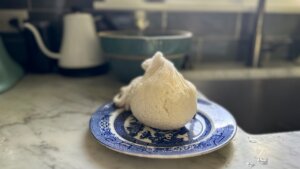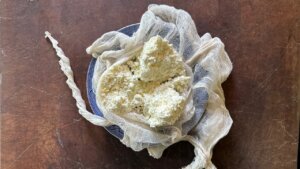Everything you need to know about cheese for Shavuot (including how to make a killer cheesecake)
Why on this day of all other days are we encouraged to eat feta, cream cheese and various dairy desserts?

Graphic by Angelie Zaslavsky
Yesterday I made farmer’s cheese for the very first time, an old-school task so simple and so satisfying that I wonder why I never attempted it before. I found the method in The Gefilte Manifesto: New Recipes for Old World Jewish Foods, by Liz Alpern and Jeffrey Yoskowitz, along with a recipe for cheesecake that calls for a mixture of farmer’s cheese, cream cheese and sour cream. Cholesterol be damned, I made that too.
This deep dive into fresh cheese — and the resulting artery-clogging-if-kick-ass cake — has to do with the holiday of Shavuot, which falls seven weeks post-Passover and celebrates both the grain harvest and the giving of the Torah to Moses on Mount Sinai.
One explanation for why we eat dairy products on Shavuot is found in a bit of scholarly word association. One of Mount Sinai’s many monikers is Mount Gavnunim. Gavnunim means “many-peaked” in Hebrew and is related to the word gevinah, which is one of three Hebrew words for cheese. Eating cheese on Shavuot can be seen as a way of commemorating Moses receiving the Ten Commandments.

The eating of dairy may also be tied to words from the Song of Songs, “Honey and milk are under your tongue,” and to the reference to Israel as the land of milk and honey. Another theory is that when the Israelites received the Torah, complete with its new set of kosher laws, they subsisted on dairy foods until they’d sorted out the whole kashering-the-meat business.
Listen to That Jewish News Show, a smart and thoughtful look at the week in Jewish news from the journalists at the Forward, now available on Apple and Spotify:
In any case, Ashkenazi Jews celebrate Shavuot with dishes such as cheesecake, blintzes, kugel,and cheese-filled kreplach. Sephardic Jews eat bourekas — often filled with feta, another fresh cheese — as well as a milk-based bread called el pan de siete cielos (the bread of seven clouds), and Syrian, Iraqi, Persian and Indian Jews enjoy cheese turnovers called sambusak among other dairy-forward delicacies.
I reached out to Yoskowitz and Alpern — whose Gefilte Manifesto is part of a larger venture called The Gefilteria, which reimagines Eastern European Jewish cuisine through events, education, and artisanal products — to talk about Shavuot foods and find out more about fresh cheeses. Alpern began our conversation by offering a more down-to-earth explanation for the dairy consumption.
“For me it’s very obvious that we eat a lot of dairy on Shavuot and that these kinds of fresh cheeses are associated with springtime,” Alpern said. “You have cows, goats and sheep being born, so there’s a lot more milk being produced, and there’s a lot more grass growing. You’ve got your milk and you want to make it last, so what are you going to do?”
You’re going to make cheese.

Making aged cheeses takes skill, as well as time and patience. But soft fresh cheeses, as I just discovered, are a fast and easy way to extend the life of milk — or make use of milk that’s gone sour — and can be incorporated into any number of savory and sweet dishes.
So what are fresh cheeses, and what distinguishes one from another? Fresh cheese is basically milk that’s been separated into curds and whey, either through fermentation or by way of an acid such as vinegar or lemon juice. In either case, the curds are drained of the liquidy whey to achieve varying degrees of dryness. (The exception is ricotta, which is made from the whey itself.) The resulting cheeses can be seasoned with salt and other flavorings or left plain; pressed or shaped or left in loose mounds.
“The differences among them are like shades of white to an interior designer, subtle but distinct;” Kim Severson said of soft cheese in The New York Times.
Farmer’s cheese is nothing more than whole milk mixed with a little acid. Per the Manifesto, I added ½ cup distilled white vinegar to a gallon of delicious local milk that I’d heated until foamy but not boiling. Adding the acid causes the curds to separate immediately from the whey, which is drained until the fluffy white curds are sufficiently dry. At this point, salt and other flavorings can be added.
Cream cheese — created in a happy accident in the late 1800s when “a Jewish dairyman from upstate New York accidentally added too much cream to a batch of soft cheese,” according to Yoskowitz — involves adding cheese starter cultures and rennet to warm milk and cream, letting it sit, then straining all the liquid from the mixture. Needless to say, bagels and cheesecake wouldn’t be the same without it. Here’s a recipe for cultured cream cheese from The Gefilte Manifesto.
Cottage cheese is basically farmer’s cheese to which additional milk or cream is added after the whey has drained off the curds, creating a more creamy consistency than that of farmer’s cheese. Long considered a diet food in the U.S., it has recently become a TikTok star, turning up in a viral video for cottage cheese ice cream and other unlikely concoctions (including cheesecake).
To make pot cheese, sometimes called “pot-style cottage cheese” or dry-curd cottage cheese — more whey is drained from the curds than with cottage cheese, and honestly I’m not sure how it differs from farmer’s cheese except that its texture is often described as a cross between the two.
Feta — ubiquitous on Israeli breakfast tables and indispensable in any number of stuffed savory pies and pastries — is a fresh cheese that’s been pressed and brined.
G’vina levana, white cheese in English, is a key ingredient in Israeli-style cheesecake. Its closest companion is German quark, a creamy, often salt-free fresh cheese that’s usually made with skim milk soured with lactic acid bacteria. Recipes for Israeli cheesecake usually call for g’vina levana and suggest quark as a substitute. The resulting cake is far lighter and fluffier than its New York-style counterpart.

I considered making an Israeli-style cheesecake for Shavuot this year, but when I came across the one in The Gefilte Manifesto, I was drawn to the idea of using the fresh farmer’s cheese I’d brought forth with my own two hands combined with the same quantity of cream cheese (and a whole lotta sour cream), which would yield a cake that’s less dense than the New York version but still has some of that tangy flavor.
The cake required very little hands-on prep time. The only hard part was mustering the patience to allow it to set properly after baking — two hours in a shut-off oven, then another six in the fridge. The waiting was agony, but the resulting cheesecake was entirely worth it. It tasted like decadence itself.
“In the kosher tradition of Jews, we don’t often have dairy desserts with our foods,” Alpern said. “That’s why it’s so exciting on Shavuot to have this dairy dessert. It almost feels a little bad — ‘Ooh, I’m going to eat cheesecake after this meal.’ I’m a grown-ass person and I still think it’s transgressive to serve dairy after a meal.”
Celebration Cheesecake
Adapted from Cheesecake with Currant Glaze and Caraway Crust in The Gefilte Manifesto, by Jeffrey Yoskowitz and Liz Alpern.
Yoskowitz and Alpern’s cake has a currant glaze and caraway crust. I didn’t have currants, but I did have rhubarb and a few strawberries, so I made a rhubarb-strawberry compote instead. I also added a big squeeze of lemon juice to the cake batter, because I knew I wanted that tang, and I left out the caraway seeds because I don’t love that flavor.
Lastly, I worried that my cake hadn’t baked long enough after the prescribed 30 minutes, so I left the oven on for an additional 20 before turning it off and leaving the cake inside as instructed. It turned out perfectly.
For the crust:
1½ cups graham cracker crumbs
4 tablespoons (½ stick) unsalted butter, melted
3 tablespoons sugar
4 teaspoons caraway seeds
For the cake:
12 ounces cream cheese, at room temperature
12 ounces farmer’s cheese, store-bought or homemade, at room temperature
1½ cups sugar
4 large eggs, at room temperature
1½ teaspoons vanilla extract
2 tablespoons fresh lemon juice (optional)
16 ounces sour cream, at room temperature
For the currant glaze:
1 teaspoon cornstarch
2 tablespoons sugar
2 teaspoons fresh lemon juice
2 tablespoons water
2 cups fresh or frozen red currants
Alternately, for Liza’s rhubarb-strawberry compote:
1 pound rhubarb, trimmed of leaves and cut into 1-inch pieces
8 strawberries, trimmed and cut in half or quarters
1 cup sugar
- Preheat the oven to 375 F. Grease a 9-inch springform pan.
- To make the crust: Combine the crust ingredients in a small bowl and pack the crust mixture firmly into the bottom of the prepared pan.
- To make the cake: In the bowl of a stand mixer fitted with the paddle attachment, or in a large bowl using a hand mixer, beat together the cream cheese and farmer’s cheese until fluffy, gradually adding the sugar in increments, then adding the eggs one by one. Add the vanilla, lemon juice (if using) and sour cream and beat until incorporated. Pour the mixture into the pan over the crust. Bake for 30 minutes. Turn off the oven and let the cheesecake sit inside, undisturbed, for at least 2 hours so it sets properly. Place it in the refrigerator and let cool completely before serving, at least 6 hours. Cheesecake is delicate, so be gentle.
- To make the red currant glaze: While cake is cooling in the oven, in a small saucepan, combine the cornstarch, sugar, lemon juice, and water and cook over very low heat, stirring, until the mixture starts to thicken, about 4 minutes. Immediately stir in the currants and cook, stirring occasionally, until the mixture begins to bubble up slightly and thicken, 10–12 minutes more. Remove from the heat and let cool. The glaze can be prepared up to 3 days in advance of serving and stored in the refrigerator.
- To make Liza’s rhubarb-strawberry compote: In a medium saucepan combine the fruit and sugar and cook over medium-low heat, stirring occasionally, until the fruit has released some of its juice and the sugar has melted into it. Simmer about 10 minutes, until the liquid has thickened into a syrup. Let cool. The compote can be prepared up to 3 days in advance of serving and stored in the refrigerator. Use any leftovers in place of jam on toast or as a topping for yogurt or ice cream.
- The cheesecake will keep in the refrigerator for up to 1 week. Serve it chilled with a spoonful of glaze (or compote) and a cup of coffee






















